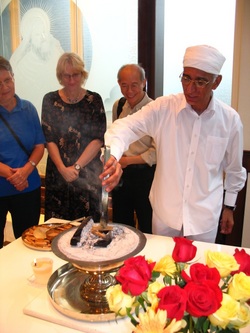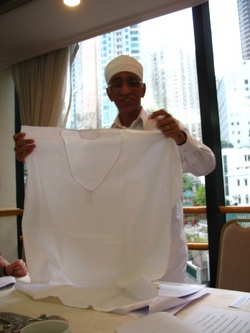|
I often consider my life to be a journey of Truth-seeking. As such, I explore a wide range of worldviews, including various world religions and atheism. With Unitarian Universalists Hong Kong (UUHK), I have paid eye-opening visits to the Eastern Orthodox Church and the Bahai community in HK. This time, on May 8, 2010, we visited the Zoroastrian community. Because of the impending visit to a stranger religion, I have done a little homework. To my surprise, members of this little-known religion have made major contributions to the British colony in her early days. More surprisingly still, this small ancient religion has a profound influence on a hugely popular religion in the West, namely, Christianity. Some biblical scholars maintain that, in the Gospel of Matthew, the magi from the east visiting the baby Jesus were Zoroastrian priests. The reason, they say, for inclusion into the narrative the then prestigeous Zoroastrian priests is to enhance the creditability of Jesus as the Messiah. Also, the Bible is full of Zoroastrian concepts: God/Satan, Heaven/Hell, Angels/Archangels, Judgment, and Bodily Resurrection. (1) On the day of visit, when I arrived at the Zoroastrian Building in Causeway Bay, I could spot the symbol of Faravahar on the outer wall (figure 2). The soft-spoken and very friendly priest Homyar explained to us the basics of his religion. The founder was Zoroaster (628-551 BCE); his name appeared in Nietzsche’s famous “Thus Spoke Zarathustra.” Zoroastrianism was the national religion of Persia and the most influential religion in the Middle East at the time of Jesus. Its main God is Ahura Mazda, “Ahura” means creator, “Mazda” wisdom. Good thoughts, good words, and good deeds are her three basic principles. The scripture is Avesta, mainly accounting the life and teachings of Zoroaster. Fire is believed to be the earliest creature, symbolizing God’s eternity and mercy; therefore, all their temples have an ever-lite sacred fire. Regarding adherents’ current religious practices, every member will wear the symbol of Faravahar, the guardian angel, as a necklace. They don’t smoke, for smoking blasphemes the fire. Every youth will pass through an adult ceremony, in which (s)he will start wearing a white underwear with a small pocket in the middle of the collar (figure 3), a symbol of keeping good deeds done every day. The religious identity is inherited and they do not accept converts. Their children are encouraged to marry within the religion. Women married to outsiders will be considered as leaving the religion, men marrying outsiders have not this problem. Priesthood is also inherited, passing only to sons. Homyar joked that he has a daughter and so his line of prienthood has been cut off. The origin of HK Zoroastrians can be traced back to the 17th century, when Muslims conquered Persia. Some Persian Zoroastrians fleed to Mumbai, India, where they were called “Parsee,” meaning a people from Persia. After the Opium War, they followed the British colonists to Hong Kong. More famous figures included Sir Hormusjee Naorojee Mody, a co-founder of the University of Hong Kong. The Mody Road in Tsim Sha Tsui was named after him. Jehangir Hormujee Ruttonjee was the founder of the Ruttonjee Hospital. The Star Ferry was started by Dorabjee Naorojee Mithaiwala. Parsees also helped establish the HSBC Bank and the Hong Kong Stock Exchange. After the introductory lecture, Homyar guided us to visit the prayer hall, the center of which is the sacred fire fed by sandalwood (figure 1). Homyar stressed that they worship not the fire, but God through the fire. Afterwards, we took a fifteen minutes walk to the Parsee Cemetery in Happy Valley, which was built as early as 1852. Celebrities’ names such as Sir Hormusjee Naorojee Mody and Jehangir Hormujee Ruttonjee can be found there. At present, however, there are only about 200 Zoroastrians in Hong Kong (only about 210 000 in the whole world) and they have been largely forgotten by the rest of Hong Kong. This visit added an important piece to the jigsaw puzzle of my life, linking together fragments such as the Star Ferry, the University of Hong Kong, the HSBC, and Christianity. It forced me to reflect deeply whether Christianity is really that special and sacred, as many of her core symbols were merely borrowed from earlier religions. Articles related to Zoroastrianism from Universalist Herald: http://www.universalist-herald.net/2Interf.html http://www.universalist-herald.net/Magi.html 我一直覺得自己的一生是一趟追尋真理的旅程。所以我對不同的世界觀感興趣,包括世界各大宗教和無神論。以前跟尋道會探訪過包括東正教和巴哈依教等世界宗教在香港的群體,大開眼界。今次,於一零年五月八日,跟她拜訪香港的瑣羅亞斯德教群體(又稱「祆教」(音軒,意即天示之教)或「拜火教」)。 因為將要拜訪這個對我來說新奇的宗教,事前找了一些相關資料。原來這個鮮為人知的宗教的教徒在香港開埠時期有著舉足輕重的貢獻。更出乎意料之外的,這個日漸式微的古老宗教原來對基督宗教影響深遠。有學者認為馬太褔音中從東方來探望嬰兒耶穌的幾個博士很可能就是祆教的祭司,並且推論馬太褔音的作者之所以將祆教祭司寫入馬槽故事之中,是希望借助這些當時德高望重的人物建立耶穌作為彌賽亞的可信性。除此之外,《聖經》原來還充滿著祆教的觀念:神與魔鬼之爭、光與黑暗、天堂與地獄、天使與天使長、最後審判、身體復活等等。(1) 拜訪當天,來到銅鑼灣善樂施大廈(外語名稱正是 Zoroastrian Building),在外牆已看見祆教的標誌 Faravahar(圖 二)。招待我們的祭司 Homyar 向我們講解該教之基本。祆教的始創人是瑣羅亞斯德(又譯查拉圖斯特拉,公元前628-551年)。尼采名著《查拉圖斯特拉如是說》就是用了他的名字。這宗教是波斯的國教,亦是耶穌時代中東一帶最具影響力之宗教。它的主神是阿胡拉·瑪茲達(Ahura Mazda,Ahura 意即「創造者」、Mazda意「智慧」)。祆教的三大基本教條是:好的思想、好的話語、好的行為。該教的主要經典是《阿維斯陀》,主要記述瑣羅亞斯德的生平及教訓。他們認為火是神最早的創造,象徵著神的絕對和至善,所以神廟必有長期點燃的聖火。 說到他們的宗教生活,祆教標誌 Faravahar 可說是守護天使,每個教徒都會作頸鍊帶在身上。他們不吸煙,因為褻瀆火。教徒一代傳一代,基本上不接受外人信教。青年在成人禮時會穿上一件白色短袖內衣 (圖三),胸前有一小袋子,象徵盛載每天的好行為。家庭鼓勵子女教內通婚,女子嫁給教外人便算離教,男子娶教外人則無問題。祭司制度是世襲的,只傳男子,Homyar 笑言他有一個女,所以斷絕了承繼。 至於香港祆教教徒的來源,可追朔到公元七世紀,伊斯蘭教征服波斯,部分堅信祆教的波斯人,於是移居印度許孟買。這些人在印度被稱為巴斯人(Parsee),即來自波斯的人。鴉片戰爭後,巴斯人隨英國人來港。香港比較著名的巴斯人有香港大學創辦人之一的麼地(尖沙咀的摩地道便以他命名)、創辦律敦治醫院的律敦治、天星小輪前身九龍渡輪公司的創辦人 Mithaiwala、滙豐銀行和聯交所的創辦成員等。此外,香港旭龢道和碧荔路也以祆教教徒命名。祆教在香港曾被稱為「白頭教」,因為祭司是戴上白帽的。 講解後,Homyar 帶我們參觀祈禱禮堂,內有檀香木聖火(圖 一),這個火,可說是崇拜的中心。但 Homyar 強調他們並非拜火,而是透過火敬拜神。之後,祭司帶領我們步行十五分鐘到達位於跑馬地的巴斯人墓園。該墓園早於一八五二年建成,可以找到一些香港開埠名人如麼地和律敦治家族的墳墓。但時至今日,香港現有祆教教徒只有約二百多人(世界祆教教徒亦只有約廿一萬),在社會上幾乎已被人遺忘。 這次探訪及相關的資料搜集讓我感覺自己的人生砌圖多了一片重要的碎片,將一些零星的片段串連起來(基督教、香港大學、天星馬頭…),亦令我深思基督教是否真的特別神聖,因為她的核心象徵只不過是自然地承傳自更早的其他宗教。 1 Ken Vincent, ‘The Zoroastrians,’ Universalist Herald, Nov/Dec 2009, p. 21. (download "zoroastrians.jpg" below)
1 Comment
Alex
29/12/2012 05:18:19 pm
HK international relations scholar Dr Simon Shen recently paid a visit to the Zoroastrian headquarters, pic: http://www.facebook.com/photo.php?fbid=515551838478971
Reply
Your comment will be posted after it is approved.
Leave a Reply. |
Categories
All
Archives
February 2022
AuthorAlex from UUHK |
||||||



 RSS Feed
RSS Feed
